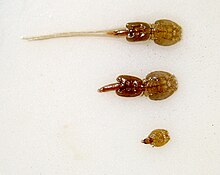Salmon louse
| Salmon louse | |
|---|---|
 |
|
| Scientific classification | |
| Kingdom: | Animalia |
| Phylum: | Arthropoda |
| Subphylum: | Crustacea |
| Class: | Maxillopoda |
| Subclass: | Copepoda |
| Order: | Siphonostomatoida |
| Family: | Caligidae |
| Genus: | Lepeophtheirus |
| Species: | L. salmonis |
| Binomial name | |
|
Lepeophtheirus salmonis (Krøyer, 1837) |
|
| Synonyms | |
|
|
The salmon louse, Lepeophtheirus salmonis, is a species of copepod in the genus Lepeophtheirus. It is a sea louse, a parasite living mostly on salmon, particularly on Pacific and Atlantic salmon and sea trout, but is also sometimes found on the three-spined stickleback. It lives off the mucus, skin and blood of the fish. They are natural marine parasites of fish such as adult salmon. Once detached they can be blown by wind across the surface of the sea, like plankton. When they encounter a suitable marine fish host they may adhere themselves to the skin, fins, the gills of the fish, and feeding off the mucus or skin. Sea lice only affect fish and are not harmful towards humans.
Salmon lice are natural ectoparasites of salmon, in the 1980s high levels of salmon lice were observed on Pink salmon smolts. Salmon lice are found in Pacific and Atlantic Oceans, they infect Pink salmon, Atlantic salmon, and Chum salmon.
There has been some research on the problems caused by this species in aquaculture, but little is known about the salmon louse's life in nature. It has been shown, however, that salmon louse infections in fish farming facilities can cause epizootics in wild fish. It is also common knowledge that when aquaculturalists place their post smolts into sea water they are obviously ectoparasite free and this can last for many months.
L. salmonis has a direct life cycle (i.e. a single host) with eight life stage. with ecdysis in between. These planktonic nauplii cannot swim directionally against the water current, but drift passively, and have the ability to adjust their depth in the water column. They are almost translucent in colour and are about 0.5-0.6mm long.
At 5 °C (41 °F) the nauplius 1 stage lasts about 52 hours, and about 9 hours at 15 °C (59 °F). Nauplius 2 takes 170 hours and 36 hours at these temperatures, respectively. They are responsive to light and salinity. Low salinities appear to have a greater effect on the planktonic stages than on the parasitic stages. Newly hatched larvae do not survive below salinities of 15‰ and poor development to the infective copepodid occurs between 20‰ and 25‰. Nauplii and copepodids are positively phototactic and exhibit a daily vertical migration, rising during the day and sinking at night. The ability to find their host is not light dependent. They have been shown to be responsive to low frequency water accelerations, such as those produced by a swimming fish. Finding their migratory host in the vastness of the ocean is still a mystery for scientists to solve but the species has managed to do this effectively for millennia.
...
Wikipedia
